1.2: Inspection, Grading, and Storage of Poultry
- Page ID
- 21231
\( \newcommand{\vecs}[1]{\overset { \scriptstyle \rightharpoonup} {\mathbf{#1}} } \)
\( \newcommand{\vecd}[1]{\overset{-\!-\!\rightharpoonup}{\vphantom{a}\smash {#1}}} \)
\( \newcommand{\id}{\mathrm{id}}\) \( \newcommand{\Span}{\mathrm{span}}\)
( \newcommand{\kernel}{\mathrm{null}\,}\) \( \newcommand{\range}{\mathrm{range}\,}\)
\( \newcommand{\RealPart}{\mathrm{Re}}\) \( \newcommand{\ImaginaryPart}{\mathrm{Im}}\)
\( \newcommand{\Argument}{\mathrm{Arg}}\) \( \newcommand{\norm}[1]{\| #1 \|}\)
\( \newcommand{\inner}[2]{\langle #1, #2 \rangle}\)
\( \newcommand{\Span}{\mathrm{span}}\)
\( \newcommand{\id}{\mathrm{id}}\)
\( \newcommand{\Span}{\mathrm{span}}\)
\( \newcommand{\kernel}{\mathrm{null}\,}\)
\( \newcommand{\range}{\mathrm{range}\,}\)
\( \newcommand{\RealPart}{\mathrm{Re}}\)
\( \newcommand{\ImaginaryPart}{\mathrm{Im}}\)
\( \newcommand{\Argument}{\mathrm{Arg}}\)
\( \newcommand{\norm}[1]{\| #1 \|}\)
\( \newcommand{\inner}[2]{\langle #1, #2 \rangle}\)
\( \newcommand{\Span}{\mathrm{span}}\) \( \newcommand{\AA}{\unicode[.8,0]{x212B}}\)
\( \newcommand{\vectorA}[1]{\vec{#1}} % arrow\)
\( \newcommand{\vectorAt}[1]{\vec{\text{#1}}} % arrow\)
\( \newcommand{\vectorB}[1]{\overset { \scriptstyle \rightharpoonup} {\mathbf{#1}} } \)
\( \newcommand{\vectorC}[1]{\textbf{#1}} \)
\( \newcommand{\vectorD}[1]{\overrightarrow{#1}} \)
\( \newcommand{\vectorDt}[1]{\overrightarrow{\text{#1}}} \)
\( \newcommand{\vectE}[1]{\overset{-\!-\!\rightharpoonup}{\vphantom{a}\smash{\mathbf {#1}}}} \)
\( \newcommand{\vecs}[1]{\overset { \scriptstyle \rightharpoonup} {\mathbf{#1}} } \)
\( \newcommand{\vecd}[1]{\overset{-\!-\!\rightharpoonup}{\vphantom{a}\smash {#1}}} \)
\(\newcommand{\avec}{\mathbf a}\) \(\newcommand{\bvec}{\mathbf b}\) \(\newcommand{\cvec}{\mathbf c}\) \(\newcommand{\dvec}{\mathbf d}\) \(\newcommand{\dtil}{\widetilde{\mathbf d}}\) \(\newcommand{\evec}{\mathbf e}\) \(\newcommand{\fvec}{\mathbf f}\) \(\newcommand{\nvec}{\mathbf n}\) \(\newcommand{\pvec}{\mathbf p}\) \(\newcommand{\qvec}{\mathbf q}\) \(\newcommand{\svec}{\mathbf s}\) \(\newcommand{\tvec}{\mathbf t}\) \(\newcommand{\uvec}{\mathbf u}\) \(\newcommand{\vvec}{\mathbf v}\) \(\newcommand{\wvec}{\mathbf w}\) \(\newcommand{\xvec}{\mathbf x}\) \(\newcommand{\yvec}{\mathbf y}\) \(\newcommand{\zvec}{\mathbf z}\) \(\newcommand{\rvec}{\mathbf r}\) \(\newcommand{\mvec}{\mathbf m}\) \(\newcommand{\zerovec}{\mathbf 0}\) \(\newcommand{\onevec}{\mathbf 1}\) \(\newcommand{\real}{\mathbb R}\) \(\newcommand{\twovec}[2]{\left[\begin{array}{r}#1 \\ #2 \end{array}\right]}\) \(\newcommand{\ctwovec}[2]{\left[\begin{array}{c}#1 \\ #2 \end{array}\right]}\) \(\newcommand{\threevec}[3]{\left[\begin{array}{r}#1 \\ #2 \\ #3 \end{array}\right]}\) \(\newcommand{\cthreevec}[3]{\left[\begin{array}{c}#1 \\ #2 \\ #3 \end{array}\right]}\) \(\newcommand{\fourvec}[4]{\left[\begin{array}{r}#1 \\ #2 \\ #3 \\ #4 \end{array}\right]}\) \(\newcommand{\cfourvec}[4]{\left[\begin{array}{c}#1 \\ #2 \\ #3 \\ #4 \end{array}\right]}\) \(\newcommand{\fivevec}[5]{\left[\begin{array}{r}#1 \\ #2 \\ #3 \\ #4 \\ #5 \\ \end{array}\right]}\) \(\newcommand{\cfivevec}[5]{\left[\begin{array}{c}#1 \\ #2 \\ #3 \\ #4 \\ #5 \\ \end{array}\right]}\) \(\newcommand{\mattwo}[4]{\left[\begin{array}{rr}#1 \amp #2 \\ #3 \amp #4 \\ \end{array}\right]}\) \(\newcommand{\laspan}[1]{\text{Span}\{#1\}}\) \(\newcommand{\bcal}{\cal B}\) \(\newcommand{\ccal}{\cal C}\) \(\newcommand{\scal}{\cal S}\) \(\newcommand{\wcal}{\cal W}\) \(\newcommand{\ecal}{\cal E}\) \(\newcommand{\coords}[2]{\left\{#1\right\}_{#2}}\) \(\newcommand{\gray}[1]{\color{gray}{#1}}\) \(\newcommand{\lgray}[1]{\color{lightgray}{#1}}\) \(\newcommand{\rank}{\operatorname{rank}}\) \(\newcommand{\row}{\text{Row}}\) \(\newcommand{\col}{\text{Col}}\) \(\renewcommand{\row}{\text{Row}}\) \(\newcommand{\nul}{\text{Nul}}\) \(\newcommand{\var}{\text{Var}}\) \(\newcommand{\corr}{\text{corr}}\) \(\newcommand{\len}[1]{\left|#1\right|}\) \(\newcommand{\bbar}{\overline{\bvec}}\) \(\newcommand{\bhat}{\widehat{\bvec}}\) \(\newcommand{\bperp}{\bvec^\perp}\) \(\newcommand{\xhat}{\widehat{\xvec}}\) \(\newcommand{\vhat}{\widehat{\vvec}}\) \(\newcommand{\uhat}{\widehat{\uvec}}\) \(\newcommand{\what}{\widehat{\wvec}}\) \(\newcommand{\Sighat}{\widehat{\Sigma}}\) \(\newcommand{\lt}{<}\) \(\newcommand{\gt}{>}\) \(\newcommand{\amp}{&}\) \(\definecolor{fillinmathshade}{gray}{0.9}\)Inspection
All poultry produced for public inspection is inspected by the USDA. It must be processed under strict sanitary guidelines and must be fit for human consumption.
Grading Poultry
USDA grades for poultry are A, B, and C
Grade “A” poultry is free of deformities and pinfeathers, free of cuts, tears, and broken bones. It has a thick flesh with a well-developed fat layer.
Grades B and C are used primarily for processed poultry products.
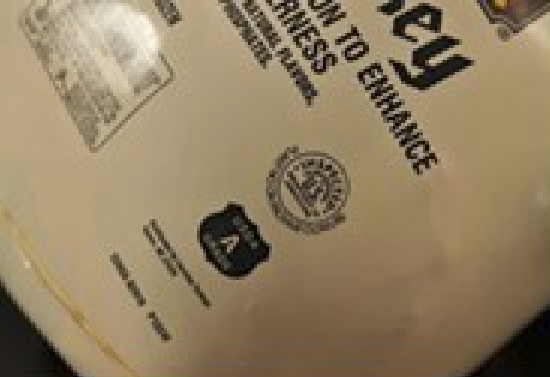
USDA inspection and grade - publicdomainfiles.com
Royalty of Poultry Offal - Foie Gras
Larger duck and geese are gavage fed in order to develop a fattened liver which is considered a delicacy. The harvesting of the animal is sustainably used and the breast from these birds are called magret (may-gray) and are usually quite large, boneless and with skin intact.
As of late the discussion regarding the raising practices have been met, especially on the West coast, with protest sponsoring a California ban on the serving of foie gras. There may have been a time in our culture when poor practices have been used, however that day is past. Reputable farms have opened their doors to the activist community and educated many on the humane principals and low stress practices in raising and harvesting these birds. Still you will hear that the livers are diseased by over feeding. This is only an uneducated assumption. In the wild these ducks and geese must forage for food in a hurried manner to avoid their natural predators while at the same time, fattening those same livers for energy needed in their long seasonal migrations. Man simply mimics nature in the raising of geese and ducks for this prized and sustainable food as he has since the times of the ancient Egyptians. You must make up your own mind in your future decisions regarding foie gras service. It is your decision as a chef.
Foie Gras can be made into a ‘torchon’, or sliced, and seared. When making pate or torchons, you must remove the veins inside of the liver. This is done carefully by separating the lobes (there are two on each liver). Then rub the inner section to warm the fat. Work a knife edge and your fingers to expose the system of veins that run throughout the liver. Peel out the veins and remove them as they are unpleasant when eating.
When searing foie gras carefully slice a section from the liver in a thickness of ½ of an inch. Mark one side with a knife-edge in a crisscross manner. Sear the crisscrossed side first in a hot pan until golden brown then repeat on the other side. No oil is necessary as the foie gras releases much fat as it sears. Reserve the remaining fat for other applications. More on Foie Gras latter
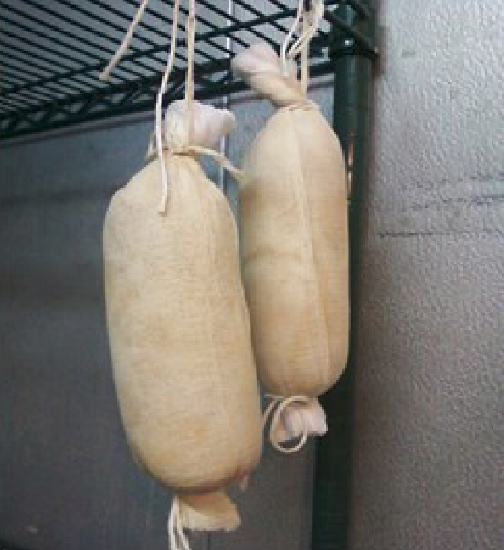
Torchons hanging after poaching - photo credit: Marshall Welsh CEC
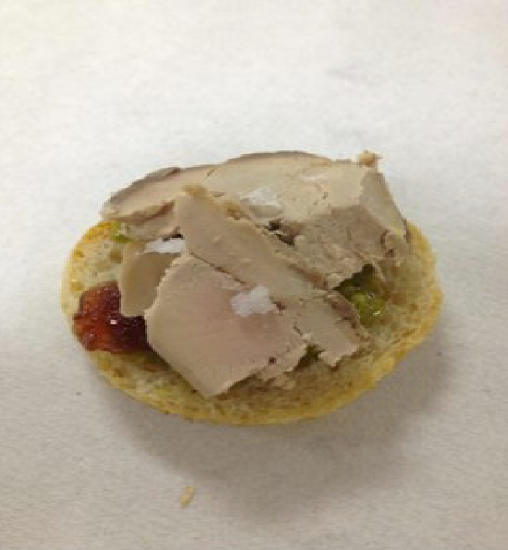
Torchon of foie gras on toast with pistachio butter, strawberry jam and fleur de sel
Photo credit: Chef Thomas Numprasong
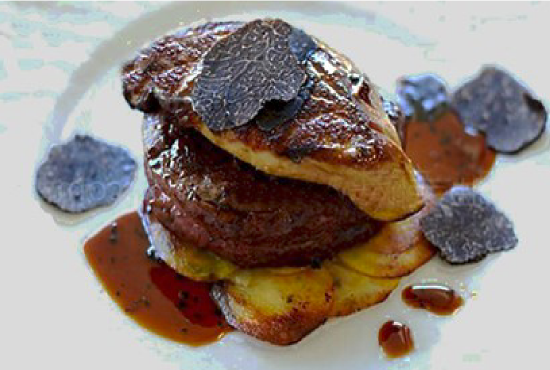
Seared Foie gras with truffles - commons.wikimedia.org
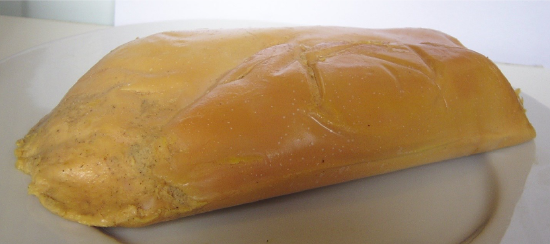
Whole Raw Foie Gras - commons.wikimedia.org
Purchasing and Storage
As always, purchase from approved reputable suppliers. Purchasing whole and fabricating yourself will save you money, but it can be labor intensive. If I am frying large quantities of chicken, I find it best to purchase in cut cases. For finer dinning where an airline breast is needed, your knife skills will usually be superior to that of a pre-cut breast.
When storing poultry under refrigeration, use drip pans and bagged ice over the top of the chicken. The drip pan allows the water to drip away from the product and the ice keeps it colder than the refrigeration. Remember that poultry is highly perishable and if frozen is best thawed under refrigeration.


